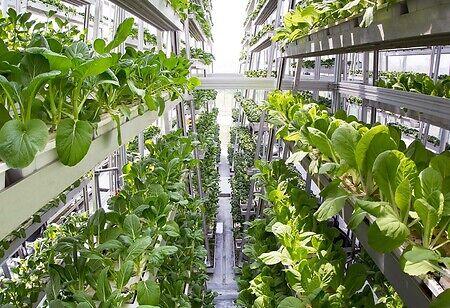
Singapore is Growing Agritech to Fix the Food Security Crisis


Singapore is one place to totally follow the crowd. Simply follow the crowd and be dazzled at the variety of street food inviting people from all over the world. However, the country is still dealing with a food security crisis that grew bigger due to climate change, COVID-19, the Russia-Ukraine war, and food export ban, among others. Its laws are focused on ensuring a consistent foreign supply of safe food and agricultural produce. Reliance on external providers is one of the main reasons for causing a food security crisis. Another major issue is that the country has minimal land to grow its own resources. But that did not discourage the nation from giving up on cultivating its own food, as it is looking at agritech solutions to push forward with its farming goals.
Egg Quality Check
New technology is making it possible for farms to automate their operations, including everything from collecting, grading, and packing eggs to feeding hens. To ensure that the eggs fulfill the freshness and quality criteria established by the Singapore Food Agency, farms are embracing the Singapore Quality Egg Scheme and implementing quality control monitoring systems. Productivity has increased thanks to automation, as has the number of eggs produced locally. Additionally, technology has made it easier to produce specialty goods like pasteurized, nutrient-rich, and ready-to-eat eggs. Consumers can be seen to have access to more locally produced, high-quality eggs as well as new product options as technology adoption continues.
Indoor Fishing Certifying More Quantity and Quality
Technology is helping to increase the quantity and quality of fish produced in the nation. Closed containment systems are now being used in certain coastal fish farms to raise fish in controlled surroundings and shield the fish from environmental hazards, including rising sea temperatures, algal blooms, and oil spills, which can kill tons of fish. Additionally, the Smart Floating Fish Farm from Singapore Aquaculture Technologies uses artificial intelligence (AI) to monitor the health and growth rates of its fish, and the Eco-Ark from the Aquaculture Centre of Excellence uses its patented technology to grow more fish using less energy and cleaner water.
Secondly, closed containment systems enable extremely productive labor, space, and resource-efficient indoor fish farming. Additionally, consumers may be guaranteed that the fish in closed containment systems are safe to eat because they are raised in conditions free of infection.
Less Space, More Yield
These farms make the most of the available physical space and establish the ideal circumstances to increase food production while using fewer resources. Sky Greens is a vertical outdoor farm that grows tropical leafy greens utilizing a rotating tier-based design that optimizes light absorption and water and soil utilization. On the other hand, indoor farms like Sustenir and VertiVegies use technology advancements to cultivate a consistent supply of fresh produce in regulated surroundings that are immune to floods, droughts, and sun damage. Agritech is employed in vegetable farms in addition to enhancing productivity to introduce fresh produce types that haven't previously been cultivated in Singapore or have seasonal availability. Due to these advancements, local residents now have year-round access to a variety of delectable fruits and vegetables, including temperate and seasonal options like kale and strawberries.
Predictive Farming
World Paradise Farm (WPF), a pioneer in Singapore's urban farming industry, has created its patented Smart Recirculating Aquaculture Aquaponics System (Decoupled RAAS), a climate-optimizing system with software that can monitor crop growth. This makes it possible for WPF to apply precision and predictive farming, a technique that boosts crop productivity by using cutting-edge sensors and analysis tools. WPF's farms are also created with a vertically stacked hydroponic technology to maximize yield per unit space. As nutrient-rich wastewater is recycled within the system, water loss is reduced.
Singapore is still doing reasonably well in terms of preserving food security, but its future is uncertain.
Prices Hikes
The Monetary Authority of Singapore stated that after 2022, elevated global food costs are anticipated to continue causing local food inflation.
The pandemic had already caused an increase in global food prices, but the conflict in Ukraine has made things worse.
According to Dil Rahut, a senior research fellow at the Asian Development Bank Institute, there will likely be food shortages for the foreseeable future, potentially even into the next year or two.
Since it takes at least a year to grow fresh fruit, other nations cannot swiftly step in to fill the gap created by Ukraine and Russia, Rahut added.
Paul Teng, an adjunct senior scholar at the S. Rajaratnam School of International Studies, cautioned that even after the war is over, food prices won't return to their pre-war levels right away.
That's because factors like rising fuel prices, manpower scarcity, and a disrupted supply chain will exacerbate the current food crisis, keeping prices high, according to Teng.
Teng further went on to say that, although Singapore might technically and technologically accomplish its aim, there are still two problems to be resolved: costs and consumer attitudes toward novel food.
According to a forecast from the World Bank, this year's predicted 20 percent increase in food costs would be followed by a decline in 2023.
Farmers all over the world are able to digitalize the agriculture supply chain to achieve greater efficiency and use data analysis to make more informed decisions, thanks to digital agritech innovations like AI and the Internet of Things. To create benchmarks and provide farmers with information about their performance, combining data from hundreds or even thousands of farms is now possible. This will enable farmers to maximize yields while minimizing resource use for the best potential outcomes.
Big data may be used by farmers to forecast crop performance, and they can even use farm robots and drones to automate tasks and gather real-time data on their operations.

